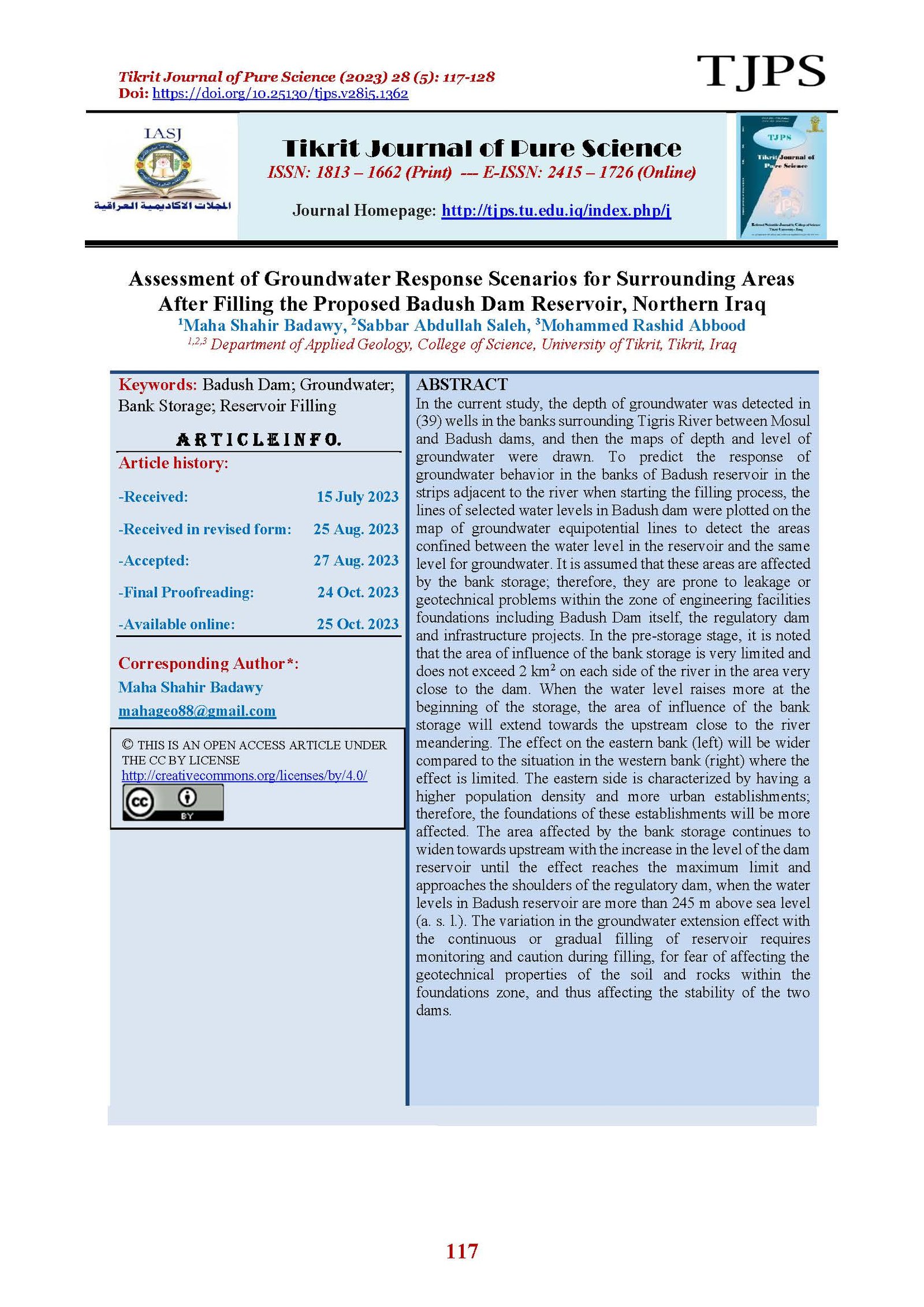Assessment of Groundwater Response Scenarios for Surrounding Areas After Filling the Proposed Badush Dam Reservoir, Northern Iraq
Main Article Content
Abstract
In the current study, the depth of groundwater was detected in (39) wells in the banks surrounding Tigris River between Mosul and Badush dams, and then the maps of depth and level of groundwater were drawn. To predict the response of groundwater behavior in the banks of Badush reservoir in the strips adjacent to the river when starting the filling process, the lines of selected water levels in Badush dam were plotted on the map of groundwater equipotential lines to detect the areas confined between the water level in the reservoir and the same level for groundwater. It is assumed that these areas are affected by the bank storage; therefore, they are prone to leakage or geotechnical problems within the zone of engineering facilities foundations including Badush Dam itself, the regulatory dam and infrastructure projects. In the pre-storage stage, it is noted that the area of influence of the bank storage is very limited and does not exceed 2 km2 on each side of the river in the area very close to the dam. When the water level raises more at the beginning of the storage, the area of influence of the bank storage will extend towards the upstream close to the river meandering. The effect on the eastern bank (left) will be wider compared to the situation in the western bank (right) where the effect is limited. The eastern side is characterized by having a higher population density and more urban establishments; therefore, the foundations of these establishments will be more affected. The area affected by the bank storage continues to widen towards upstream with the increase in the level of the dam reservoir until the effect reaches the maximum limit and approaches the shoulders of the regulatory dam, when the water levels in Badush reservoir are more than 245 m above sea level (a. s. l.). The variation in the groundwater extension effect with the continuous or gradual filling of reservoir requires monitoring and caution during filling, for fear of affecting the geotechnical properties of the soil and rocks within the foundations zone, and thus affecting the stability of the two dams.
Article Details

This work is licensed under a Creative Commons Attribution 4.0 International License.
Tikrit Journal of Pure Science is licensed under the Creative Commons Attribution 4.0 International License, which allows users to copy, create extracts, abstracts, and new works from the article, alter and revise the article, and make commercial use of the article (including reuse and/or resale of the article by commercial entities), provided the user gives appropriate credit (with a link to the formal publication through the relevant DOI), provides a link to the license, indicates if changes were made, and the licensor is not represented as endorsing the use made of the work. The authors hold the copyright for their published work on the Tikrit J. Pure Sci. website, while Tikrit J. Pure Sci. is responsible for appreciate citation of their work, which is released under CC-BY-4.0, enabling the unrestricted use, distribution, and reproduction of an article in any medium, provided that the original work is properly cited.
References
[1] Xiaosi Su, Shuai Lu, Ruimin Gao, Dong Su, Wenzhen Yuan, Zhenxue Dai and Eleftherios N. Papavasilopoulos (2017). Groundwater flow path determination during riverbank filtration affected by groundwater exploitation: a case study of Liao River, Northeast China, Hydrological Sciences Journal, 62(14):2331-2347, DOI: 10.1080/02626667.2017.1383609
[2] Milanovic, P.(2002). Subsidence hazards as a consequence of dam, Reservoir and tunnel, construction, Int. J. Speleol., 31(4):169-180.
[3] Rhodes, K. A., Proffitt, T., Rowley, T., Knappett, P. S. K., Montiel, D., Dimova, N., and Miller, G. R. (2017). The importance of bank storage in supplying baseflow to rivers flowing through compartmentalized, alluvial aquifers. Water Resources Research, 53(10):539–557. https://doi.org/10.1002/ 2017WR021619.
[4] Gillefalk, M., Massmann, G., Nützmann, G., and Hilt, S. (2018). Potential impacts of induced bank filtration on surface water quality: A conceptual framework for future research. Water, 10(9), 1240.
[5] Wheeler, K. Jeuland, M. Strzepek, K. Hall, J. Zagona, E. Abdo, G. Basson, T., Blackmore, D. Block, P. and Whittington,. D. (2022). Comment on ‘Egypt’s water budget deficit and suggested mitigation policies for the Grand Ethiopian Renaissance Dam filling scenarios’, IOP Publishing, Environmental Research Letter, 17, 088003.
[6] Chen, N.C., Wen, H.Y., Li, F.M., Hsu, S.M., Ke, C.C., Lin, Y.T., and Huang, C.C. (2022). Investigation and Estimation of Groundwater Level Fluctuation Potential: A Case Study in the Pei-Kang River Basin and Chou-Shui River Basin of the Taiwan Mountainous Region. Appl. Sci., 12, 7060. https://doi.org/10.3390/ app12147060.
[7] Chen, Q.Z., Tang, Y.H., He, M. and Rong, C. (2014). Modelling the construction of a high embankment dam, KSCE Journal of Civil Engineering, 18(1):93-102.
[8] Boehlert, B. Strzepek, K.M. and Robinson, S. (2017). Analyzing the economy-wide impacts on Egypt of alternative GERD filling policies, The Grand Ethiopian Renaissance Dam and the Nile Basin (New York: Routledge), 138–57.
[9] Razouki,R.F. (2022). Hydrogiomorphology of the Badush Dam area, Lark Journal of Philosophy, Linguistics and Social Sciences, 37: 407-424.
[10] Al-Kubaisi, Q.Y.S., (1992). Hydrodynamic properties of groundwater in Badush Dam area), Master Thesis (unpublished), University of Baghdad, College of Science.
[11] Al-Musleh, Sh.S.Z., and Al-Ansari, N.A. (2013). Hydrogeological and hydrochemical situation of Badush Dam site, central north of Iraq, for the Period 1988-1990, Iraqi Journal of Geology and Mining, 9(1):1-28.
[12] Al-Kraaey, N.A.K., Al-Omary, F.A.M., Al-Kaisy, S.A.S., (2022). Analysis of immersed geological formations for Bekhmeh dam reservoir/ Erbil, Tikrit Journal of Pure Science, 27(1):50-76. doi:http://dx.doi.org/10.25130/tjps.27.2022.007.
